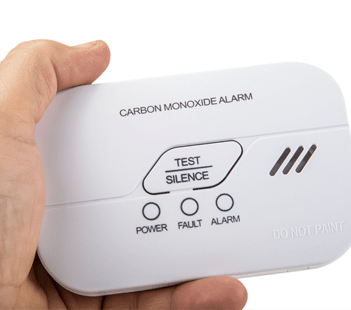Carbon Monoxide (CO) Safety Tips
January 01, 2017
Carbon monoxide is an invisible, odorless, colorless gas created when fuels (such as gasoline, wood, coal, natural gas, propane, oil, and methane) burn incompletely. Sources of carbon monoxide in the home include heating and cooking equipment that burn fuel, like a gas stove or fireplace.
Each year, thousands of people are treated at hospital emergency rooms for CO poisoning; unfortunately hundreds of people die (Centers for Disease Control and Prevention/Consumer Product Safety Commission).
Prevent Carbon Monoxide Poisoning
- Make sure appliances are installed and operated according to the manufacturer’s instructions and local building codes. Most appliances should be installed by qualified professionals. Have the heating system professionally inspected and serviced annually to ensure proper operation. The inspector should also check chimneys and flues for blockages, corrosion, partial and complete disconnections, and loose connections.
- Avoid using a portable generator or any other gasoline engine-powered tool in or near an enclosed space such as a garage, house, or other building. Even with open doors and windows, these spaces can trap CO and allow it to quickly build to lethal levels.
- Install CO alarms in the every sleeping area of the home.
- If you cannot afford to do this, install one in the hallway near every sleeping area or one on each level. Make sure the alarm cannot be covered up by furniture or draperies.
- Avoid using portable fuel-burning camping equipment inside a home, garage, vehicle or tent unless it is specifically designed for use in an enclosed space and provides instructions for safe use in an enclosed area.
- Avoid burning charcoal inside a home, garage, vehicle, or tent.
- Avoid running your car in an attached garage, even with the garage door open.
- Avoid using gas appliances such as ranges, ovens, or clothes dryers to heat your home.
- Do not cover the bottom of natural gas or propane ovens with aluminum foil. Doing so blocks the combustion air flow through the appliance and can produce CO.
- During home renovations, make sure appliance vents and chimneys are not blocked by tarps or debris. Make sure appliances are in proper working order when renovations are complete.
- During and after a snowstorm, make sure vents for the dryer, furnace, stove, and fireplace are clear of snow build-up.
- Gas or charcoal grills can produce CO — only use outside.
Maintain Your CO Alarms
CO alarms always have been and still are designed to alarm before potentially life-threatening levels of CO are reached.
- Follow the manufacturer’s instructions.
- Test your alarm monthly by using the test button.
- Look for your alarms expiration date and replace as needed.
- CO alarms may be installed into a plug-in receptacle or high on the wall. Hard wired or plug-in CO alarms should have battery backup.
Never Ignore an Alarming CO Alarm
It is warning you of a potentially deadly hazard. If your alarm is going off, do not try to find the source of the CO. Prompt medical attention is important if you are experiencing any symptoms of CO poisoning, take the following action:
- Call 911 if think you are experiencing any of the symptoms of CO poisoning.
- Immediately get outside to fresh air.
- Leave the home and call your fire department to report your symptoms from a neighbor’s home.
- Avoid re-entering your home; you could lose consciousness and die.
- Tell the paramedics/doctors that you suspect CO poisoning.
- If the source of the CO is determined to be a malfunctioning appliance, DO NOT operate that appliance until it has been properly serviced by trained personnel.
Symptoms of CO Poisoning
A person can be poisoned by a small amount of CO over a longer period of time or by a large amount of CO over a shorter amount of time. Because CO is odorless, colorless, and otherwise undetectable to the human senses, people often don’t realize they are being exposed to this harmful poison. Initial symptoms of low to moderate CO poisoning are similar to the flu (but without the fever). Symptoms include:
- Headache
- Fatigue
- Shortness of breath
- Nausea
- Dizziness
High level CO poisoning results in progressively more severe symptoms, including:
- Mental confusion
- Vomiting
- Loss of muscular coordination
- Loss of consciousness
- Ultimately death
Manage Your Healthcare From Anywhere, At Any Time
Create a New Account
Existing MyChart Account



